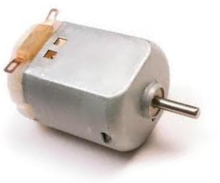What are DC Motors?

DC Motors are two-lead, electrically controlled devices that come with a rotary shaft on which wheels, gears, propellers, etc. can be mounted on.
When the DC motors are powered with sufficient voltage, the rotary shaft spins, which causes the attached device, wheels, gears, etc., to turn.
DC motors generate a considerable amount of revolutions per minute (rpm's) for their size and can be made to rotate clockwise or counterclockwise by reversing the polarity applied to the leads.
Most DC motors provide rotational speeds anywhere between 3000 and 8000 rpm at a specific operating voltage typically set between 1.5 and 24V. Check the datasheet of the DC motor in use. The operating voltage provided by the manufacturer tells you at what voltage the motor runs most efficiently.
To adjust the speed of the DC motor, the voltage applied to the motor can be made slightly lower to make the motor slower or can be elevated to make the motor faster.However, when the applied voltage drops to below around 50 percent of the specified operating voltage, the motor usually will cease to rotate. Conversely, if the applied voltage exceeds the operating voltage by around 30 percent, there's a chance the motor will overheat and become damaged. So use these parameters when adjusting speeds, not to go 50% or below or above 30% of the operating voltage.
Related Resources
How to Build a DC Motor Circuit
DC Motor Specifications- Explained
What is a Transducer?